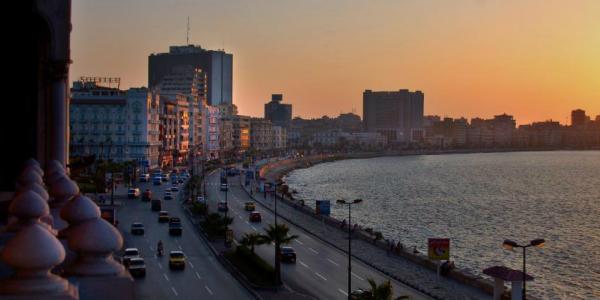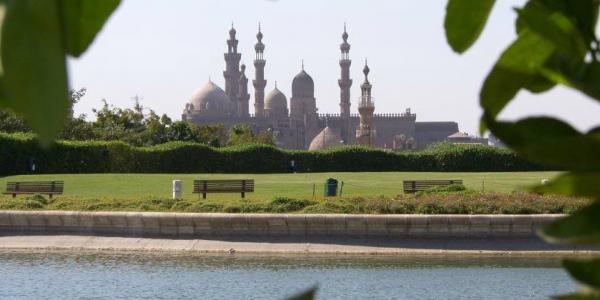Cairo has a total of 650 Islamic monuments, many of them of the very first order. The metropolis with the highest population in the Arabic world, and indeed in Africa, has an opulent wealth of Islamic art and architecture, left behind by the successive dynasties that embellished it.
All that remains of ancient Fustat from the Umayyad period is the Amr Mosque, the first on African soil. As regards the Tulunids and their settlement al-Qata’i, we still have the Ibn Tulun Mosque in marvellous condition. From the time of the Abbasids, we have the Nilometer, used for measuring the water level during flooding of the Nile and the Fatimids must be thanked for the foundation of Al-Qahira, its illustrious Mosque-University of al-Azhar and the al-Hakim Mosque. The city reached the height of its splendour during the Mameluke period (1250-1516), when its skyline bristled with the minarets of majestic mosques and madrasahs (Sultan Hassan, al-Ghuri….) and with the domes of magnificent mausoleums (Qalawun, Qaitbay….). Under Ottoman domination (16th to 19th centuries) Cairo was also regaled with numerous new features such as the exquisite Palaces and Gardens (Bayt al-Suhaimi) and the sabil-kuttab (drinking fountain/elementary school). The imposing Mosque of Muhammad Ali, perched on the summit of the Citadel, symbolized the power of this Governor, the creator of the modern Egyptian state. In total, Islamic Cairo has about 650 Islamic monuments which reproduce the grandeur of the pyramids of Giza, situated just a few kilometres away on the other side of the Nile.
Bab Zuweila
One of the three surviving ancient gates of Cairo, Bab Zuweila is a stunning example of Fatimid architecture and marks the southernmost end of the old Fatimid city.
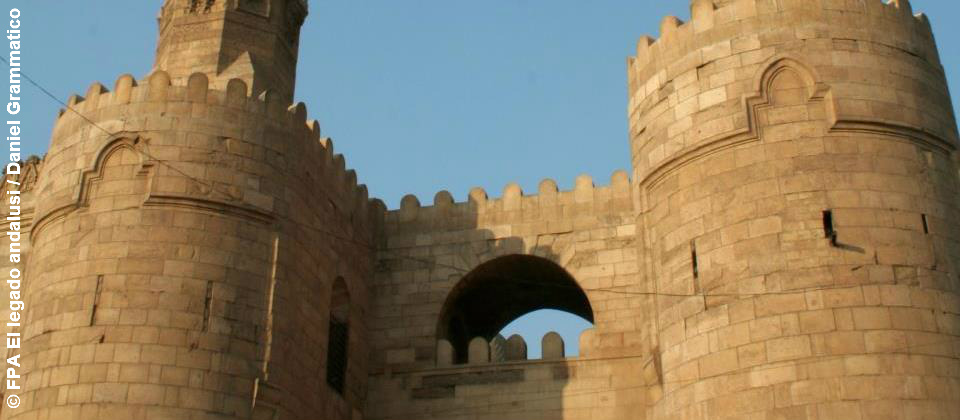
The gate has two beautifully adorned minarets belonging to the nearby al-Mu’ayyad Mosque, which are open to visitors. If you climb the steep steps, you will be rewarded with one of the best views of Old Cairo. The gate also shares a wall with the mosque and is a must-see sight in Islamic Cairo.
Sultan al-Mu’ayyad Sheikh Mosque
Located near Bab Zuweila in Cairo, this is a mosque with an interesting story. The founder, a Mameluke sultan, was imprisoned on this site and endured great suffering. He vowed that if he ever came to power he would transform the prison into a school and mosque where scholars could come to study.
After regaining his freedom, he did just that, turning the prison into one of the most beautiful and expensive mosques and madrasas to be built in Cairo. Marble in a wide array of colours was brought from different locations to adorn the walls, ceiling and floors in awesomely beautiful designs. It was built between 1415 and 1421 AD.
The Mosque’s twin minarets rise up above Bab Zuweila to dominate the area. The Sultan and his family are buried here in impressive mausoleums.
Mosque of Amr
Built in 642 AD out of palm trunks and fronds, it was the first mosque erected in Egypt and indeed in Africa. The Muslim General Amr Ibn al-'As decided to build the mosque on the place where he had pitched his tent during his conquest of the area.
The capital of Islamic Egypt al-Fustat developed around this initial site. Approximately 200 of the columns used in the mosque were recycled from older sites, and the broad, quiet spaces offer a peaceful sanctuary from the bustle of Cairo.
The mosque of Amr Ibn al-'As is part of what is commonly known today as the "Multi-Religious Compound", an area of Cairo that is home to ancient places of worship from the three monotheistic religions: Islam, Christianity and Judaism.
Al-Aqmar Mosque
Al-Aqmar mosque makes up for its size with its architectural and historical significance. Located near the al-Qalawun Complex, al-Aqmar is one of the only remaining Fatimid mosques in Cairo. It was the first mosque in Cairo to have a decorated façade, and the first to follow the line of the street. Visitors should take in the intricate, delicately carved motifs on the walls, façade and minaret of this truly beautiful mosque built in 1125 AD.
Sulayman Agha al-Silahdar Mosque
Named after its founder, Sulayman Agha al-Silahdar, one of Mohamed Ali's lieutenants, this beautiful mosque on Al-Mo'ez Street dates back to 1839. It is renowned for its "pencil-like" minaret: a tall, thin structure built in Ottoman style. What makes this mosque appear so elegant is its mixture of Ottoman, Cairene and other unexpected architectural styles; you might even spot some Baroque features on the pillars.
You should also look out for the refined window grilles featuring arabesque patterns. The Sulayman Agha al-Silahdar Mosque also includes a beautiful round sabil (water fountain).
Nilometer
Located on the lower end of Rhoda Island, the Nilometer was used to measure the level of the river in times past. The structure consists of a measuring device, a graduated column sitting below the water level, reached by steps that wind around the chamber housing the column. If the water dropped below a certain level, Cairenes could expect drought and famine; if it rose too high they could face flood and disasters. The Nilometer is no longer in operation today but is definitely worth a visit.
Built in 861 AD by the Abbasid Caliph al-Mutawakkil, it is crowned by an interesting pointed dome that was reconstructed after being destroyed by the French.
Museum of Islamic Art
The Museum of Islamic Arts in Cairo is considered one of the greatest of its kind, with exceptional collections and a main façade adorned with decorations and recesses inspired by Islamic architecture. It has pieces from all the different periods starting with the Umayyad dynasty. It re-opened in 2010 after eight years of renovation and reorganization of the collection, which has been acquired over the years from various sources: excavations, purchases, gifts and important Islamic monuments in Cairo. It owns an impressive selection of ceramics, textiles, metalwork, carved wood and stone artefacts that illustrate the material culture of Egypt from the 7th-19th centuries. The exhibition begins with the Umayyads and continues with the Abbasid/Tulunid, Fatimid, Ayyubid, Mameluke and Ottoman periods. The second half of the tour includes artefacts from Ottoman Turkey, Persia and al-Andalus, as well as various themed sections.
Museum of Islamic Ceramics
The Museum of Islamic Ceramics was inaugurated in February 1999. It occupies the ground and first floors of Prince Amr Ibrahim's palace in the National Centre for Arts in the Zamalek district. The palace was built in the first quarter of the 20th century and is known for its impressive Islamic architecture and decoration. The museum houses a rare collection of ceramics obtained from different Islamic countries from East to West, from Iran to Morocco. The collection comprises over three hundred artefacts dating from the 10th to the 19th centuries AD. In addition to ceramics, the collection also has exhibits of calligraphy, textiles, glassware and tapestries that date back to various Islamic eras.
The Museum consists of 23 rooms surrounding the main hall, which is covered with a beautiful dome adorned with colourful glasswork. The rooms encircle a splendid 19th century fountain. The most important room in the museum is the rectangular Fatimid hall, which has 74 exhibits. The walls in this room are decorated with Turkish ceramics in blue, white, and red, while the ceiling is covered with plant motifs and the motto of the Fatimids, "No conqueror but Allah," is repeatedly inscribed on the walls. Another important hall is the Turkish hall, which has 96 pieces. The two big windows in the hall have Arabesque designs. An equally important hall is the Egyptian hall, which has 39 pieces from the Umayyad, Fatimid, Ayyubid and Mameluke eras and also exhibits pieces from Syria. The ceiling is decorated with geometrical motifs. The collection on the upper floor includes Iranian ceramics, two pieces from al-Andalus, two pieces from Tunisia and two bowls from Iraq. The museum also houses interesting collections of gorgeous colourful plates, tiles and 11th century hand grenades from various Islamic countries.
The Egyptian Museum
The Egyptian Museum in Cairo contains the world's most extensive collection of pharaonic antiquities. The original collection was established in the late 19th century by Auguste Mariette in the Bulaq District. In 1891 the pieces were moved to the palace of Ismail Pasha in Giza before being transferred in 1902 to the current building at Tahrir Square, the first purpose-built museum edifice in the world.
Designed in the Neoclassical style by Marcel Dourgnon, the Egyptian Museum boasts 107 halls filled with artefacts dating from the prehistoric through to the Roman periods, with the majority of the collection focused on the pharaonic era. The museum has two main floors housing approximately 160,000 objects covering 5,000 years of Egypt’s past. The ground floor takes the visitor on a chronological tour through the collections, while the objects on the upper floor are grouped according to tomb or category; exhibits here include the treasures of Tutankhamun, wooden models illustrating daily life, statuettes of divinities, and a rare group of Faiyum Portraits. Many of the royal mummies from the New Kingdom are also on display on the second floor.
Citadel of Cairo / Qalaat Salah el-Din
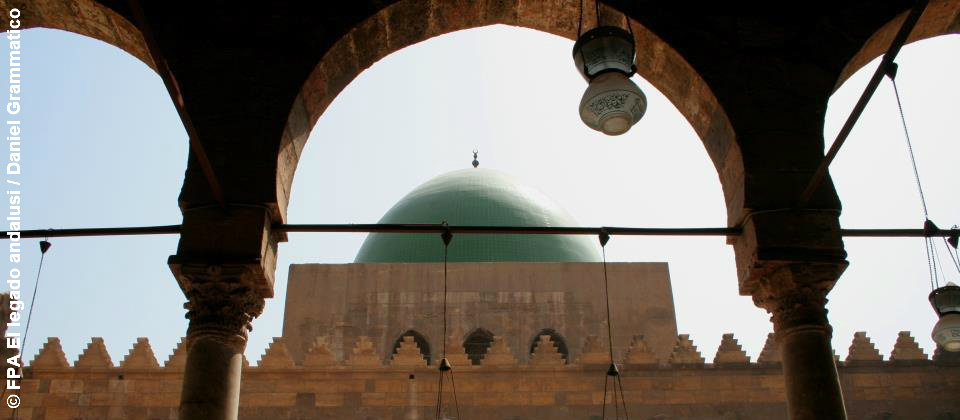
The Citadel of Cairo was built in 1176 AD by Salah el-Din (Saladin). It is one of the world’s greatest monuments to medieval warfare. Resembling a typical early medieval fortress, with large imposing gateways, towers and high defensive walls, the Citadel is one of Cairo's main attractions and probably its most popular non-pharaonic monument. The prominent fortress houses three mosques (including the impressive Mohamed Ali Mosque), a carriage museum, a military museum and a garden museum. The Citadel is also home to the impressive Gawhara Palace (the Jewel Palace), named after Gawhara Hanem, Mohamed Ali's last wife. Built in 1814, it was his personal residence and administration headquarters. Beautiful gold inscriptions adorn the walls of this majestic Ottoman-influenced palace. One of its most eccentric components is the Watch Hall, where watch-shaped motifs adorn the walls.
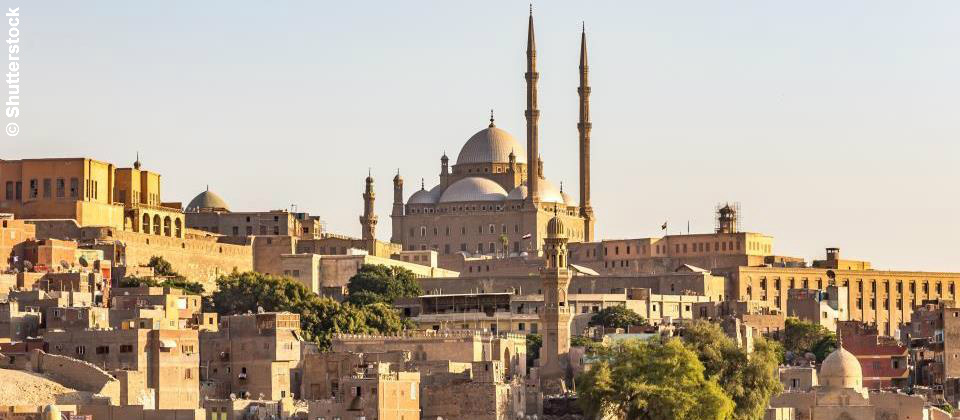
Medieval Cairo (Islamic District)
Those visiting Cairo’s Islamic District (al-Mu'izz al-Din Street, al-Azhar Street, Darb al-Ahmar Street, al-Saliba Street and Salah al-Din Square) will discover Egypt as it once was during the golden age of Islamic architecture. These medieval streets have been restored and are considered open museums that are wonderful to visit at night.
Al-Ghouri Complex
Sultan Qansuh al-Ghouri was a Mameluke sultan who reigned from 1501 to 1516, when he died at the Battle of Marj Dabiq near Aleppo. At the battle the Mamelukes were routed by the Ottomans, so bringing their dynasty to its knees. Al-Ghouri spent a fortune building his complex in Cairo, which dates back to 1503 AD. Although he was renowned for his cruelty and despotism, he was also known for his love of flowers, music, poetry and architecture. His cultural refinement is manifested in the different features of the complex.
The complex stands on both sides of the famous al-Mu'izz Street; the mosque and madrasa are on the western side, and the khanqah (building where teachers (sheikh) can gather with their disciples), mausoleum and Sabil-Kuttab are on the eastern side. The Sabil-Kuttab had two functions as a public drinking fountain (sabil), traditionally built by wealthy people to provide drinking water for the residents of a town, and as a school (kuttab) on the first floor. The mausoleum is not the final resting place of the Sultan, whose body was never recovered from the battlefield.
The two parts of the complex are out of line with the street, thus creating an irregular shaped courtyard between the two buildings. The mosque’s minaret has four storeys, just like the original minaret of the Aqsunqur mosque (the Blue Mosque). These are the only two known minarets in Cairo that have four storeys instead of the usual three. Since 1995, the complex hosts cultural events in the Khanqah hall, such as Nubian music concerts, Tannoura dance performances and religious recitals.
Al-Qalawun Complex
Also located on al-Mu'izz Street, the Qalawun complex was built by the Mameluke Sultan al-Nassir in 1304 AD in honour of his father Qalawun.
The complex houses a mosque, a madrasa (school), a bimaristan (hospital) and a mausoleum where Sultan Qalawun is buried. It is often described as the second most beautiful mausoleum in the world, behind the Taj Mahal...
Sultan al-Ashraf Barsbay Funerary Complex
Sultan al-Ashraf Barsbay (1422-1438) completed this religious complex around the year 1425. It is located to the North of Khan el Khalili and the Sultan’s other complex in Souq El Nahassin (Market of the Coppersmiths). It included a madrassa (school) where students of Islam could study. Ten of these students lived in rooms in the complex.
Some of the elements of the complex, such as the prayer hall, are unusual for this period. Notice the pairs of columns and the three arches forming three aisles in the prayer hall, lit up from windows on both the Eastern and Western façade. The sanctuary is also unusual in that although the walls are bare, it has stucco work and stained glass in addition to very impressive coloured marble floors. High above the worshippers in the dome is a beautiful star pattern, below which is the minbar (pulpit) with elaborate geometrical decorations in ivory, considered the most beautiful Mameluke minbar in Cairo. The Sultan is buried in the mausoleum attached to the prayer hall.
Amir Sarghitmish Madrasa and Mausoleum
Famous for its beautiful lanterns, this small institution is located right next to the Mosque of Ibn Tulun on al-Saliba Street. It was built in 1356 AD and served as a madrasa, a mosque, an orphanage and finally a mausoleum, once Amir Sarghitmish had passed away.
Many of the teachers at this madrasa came from Persia, hence the use of Persian styles in the architecture and interior features. While on your visit, notice the exotic dome and the red and white coloured masonry on the minaret, as well as the way the mausoleum is oriented towards the street so that passers-by can bless the deceased.
Khan El Khalili Market
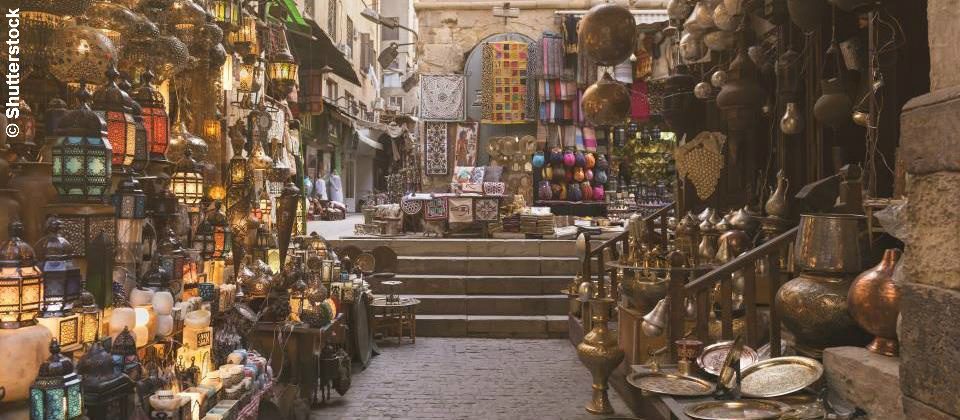
No visit to Cairo would be complete without a stop at the Khan El Khalili bazaar, where you will be transported back in time to the traditional Arab souk. Shop owners calling you to their stalls, the scent of spices, the hustle and bustle of trade, and the many beautiful objects that can be purchased, such as statuettes, spices, souvenirs, silver jewellery, t-shirts, galabiyyas, belly dancing costumes and many other items typical of Egyptian culture and traditions.



